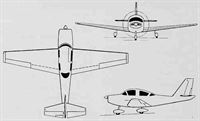
Фотографии
-
Aviation Historian 27
Two views of the LIPNUR SU-200 Sikumbang preserved in the Indonesian Air Force Museum at Yogyakarta.
-
Aviation Historian 21 / N.Stroud - Indonesia's fledgling insects
The sole NU-200 Sikumbang aloft after its first flight in August 1954. Bearing a large “X” on the tail to denote its experimental status, the “Bee” also carried the nation’s red-and-white pentagon marking and the serial “01”. The bare-metal fuselage was wrapped with a yellow band and the upper surfaces and fin were orange-red.
-
Aviation Historian 21 / N.Stroud - Indonesia's fledgling insects
An air-to-air study of the NU-200, the first original design of the Air Force's Experimental Section which commenced flight testing in August 1954, showing the aircraft’s straight-tapered wing, which was of single-piece wooden construction with an aspect ratio of 6-5:1. Contemporary press reports highlighted the NU-200’s similarity in intended role to the USA’s Fletcher FD-25 Defender COIN aircraft, which was not adopted by American forces.
This aircraft is today mounted on a pedestal at the entrance of the Nurtanio factory. -
Air Pictorial 1955-04 / The journal of a roving spotter
NU-200 Sikumbang. First flown in August 1954, the NU-200 Sikumbang is the second powered aircraft to be built in the Republic of Indonesia. A single-seater, it is intended as a prototype general purpose close-support aircraft probably to be armed with machine guns and bombs or rockets. No announcement has yet been made on production of the type.
Salient features: A low-wing monoplane, the Sikumbang has domed braced canopy, long nose and blunt fuselage tail. The nose has a distinct hump on it and the propeller boss is covered by a pointed spinner. Wings are equi-tapered and square-cut with prominent trailing-edge root fillets. The fin is equi-tapered with slightly rounded top and small dorsal fillet. The fixed undercarriage has cantilever legs which are forward raked. A small fixed tailwheel is also fitted. -
Aviation Historian 21 / N.Stroud - Indonesia's fledgling insects
Major Nurtanio Pringgoadisuryo stands beside the NU-200 Sikumbang on its roll-out at Bandung in the summer of 1954. For this article we have used the Indonesian custom of putting the surname first.
-
Aviation Historian 21 / N.Stroud - Indonesia's fledgling insects
The Sikumbang awaits another flight from Husein Sastranagara Air Force Base at Bandung, with an AURI Consolidated PBY in the background. The pilot sat just above the leading edge under a sliding cockpit canopy which provided an excellent view in all directions.
Другие самолёты на фотографии: Consolidated PBY Catalina - США - 1935
-
Air International 1980-04 / ??? - Nurtanio: Indonesian industry
The NU-225 Sikumbang flown in September 1957. This retained little more than a configurational resemblance to the original NU-200.
-
Aviation Historian 21 / N.Stroud - Indonesia's fledgling insects
The cockpit of the NU-200 was relatively simple, but included all the necessary basics, including altimeter, r.p.m. gauge, airspeed indicator, turn-and-bank indicators, compasses, fuel gauge, climb meter and manifoldpressure gauge. The throttle box was located on the port side, above the trim-control equipment, seen at LEFT.
-
Air Pictorial 1955-04 / The journal of a roving spotter
NU-200 Sikumbang. Data: Manufacturer: Indonesian Air Force, Technical Staff, Aircraft Maintenance Depot, Experimental Section, Bandung, Java. Power: one de Havilland Gipsy Six of 200 h.p. Accommodation: single-seat. Dimensions: span 34 ft. 9in.; length 26 ft. 9 in.; height 11 ft. All-up weight: 2,400 lb. Performance: maximum speed at sea level 160 m.p.h.; cruising 140 m.p.h.; landing speed 55 m.p.h.; initial rate of climb over 1,000 ft. per min.; service ceiling 16,500 ft.; range 600 miles.
-
Jane's All the World Aircraft 1964 / 01 - Aircraft
Kumbang Model 260 four-seat light aircraft









